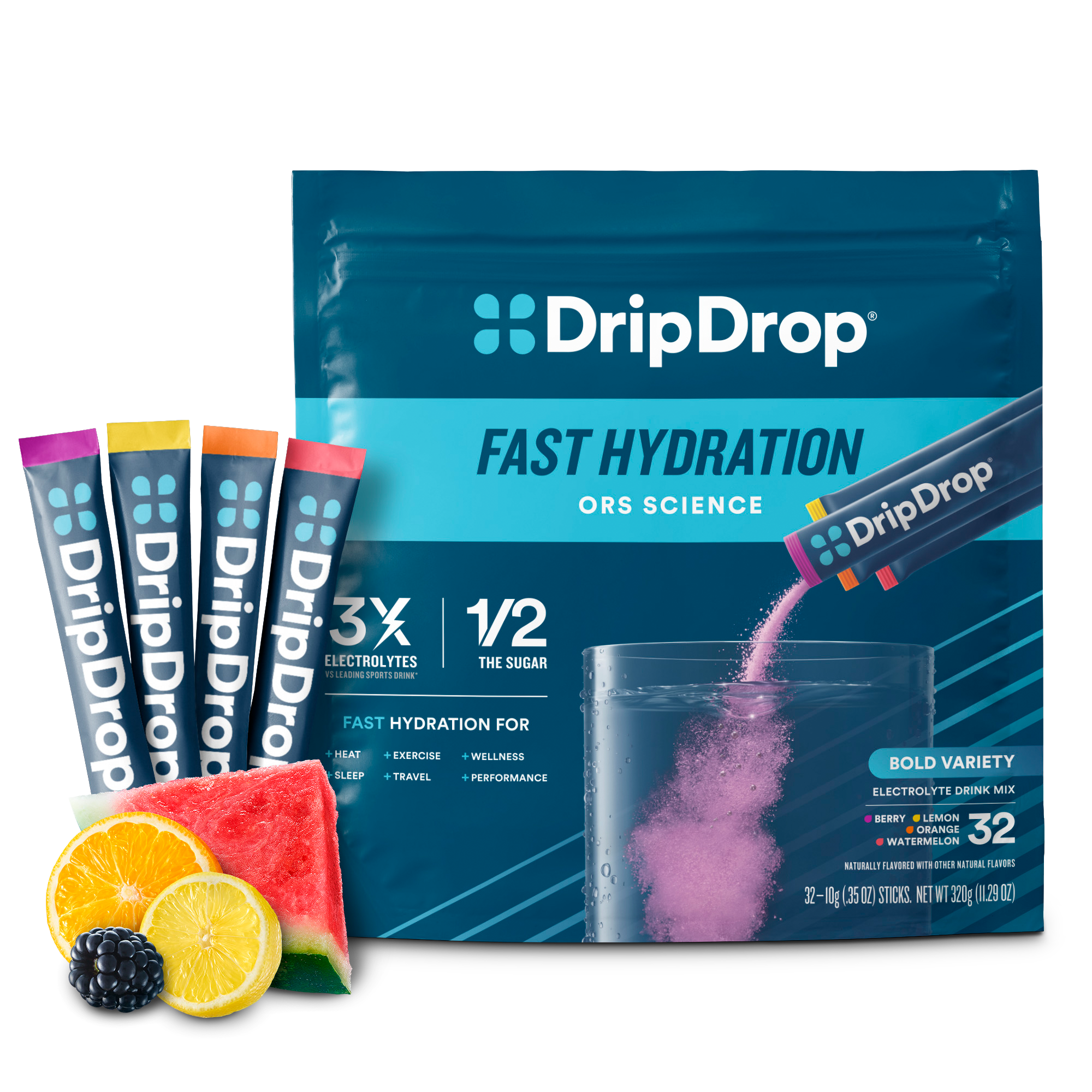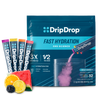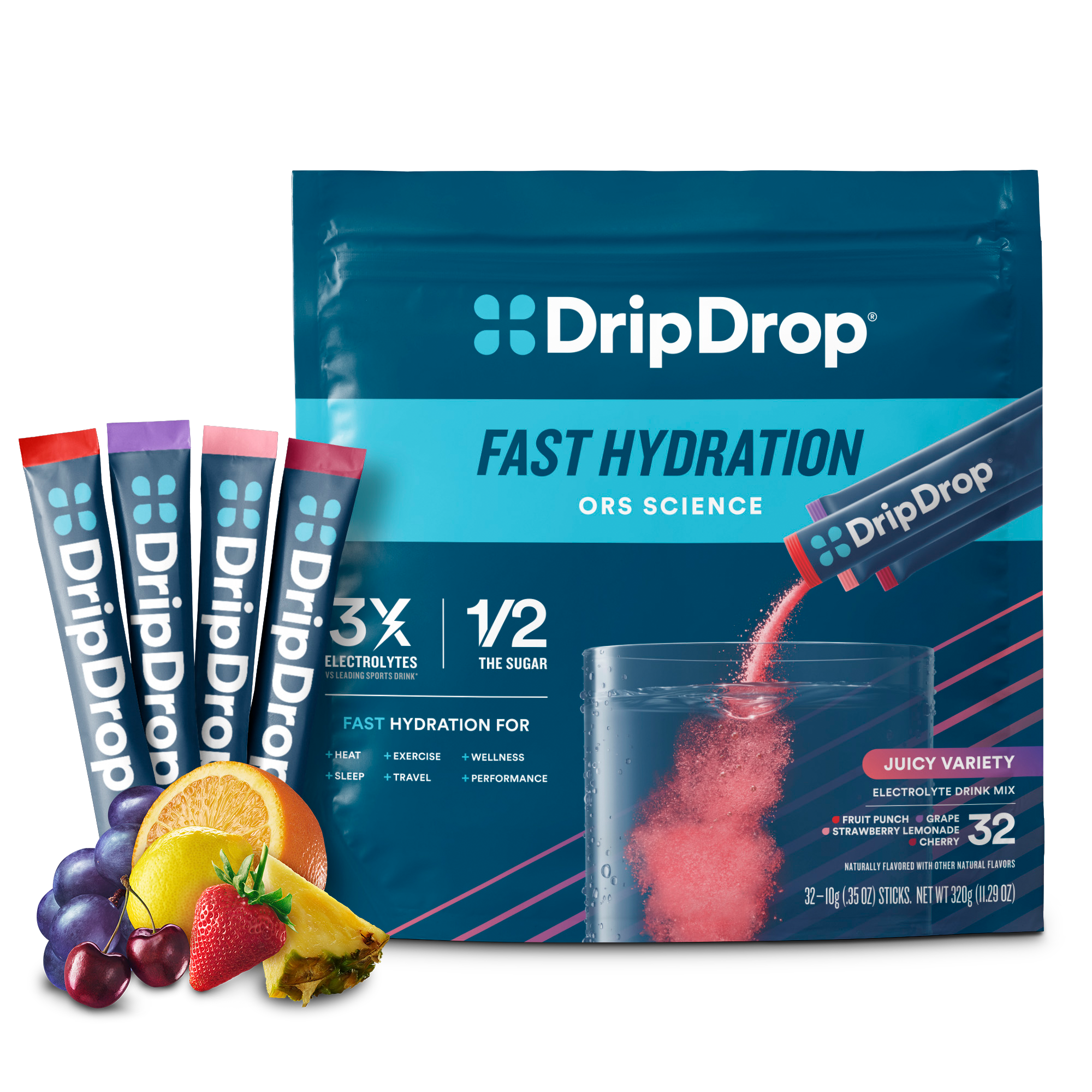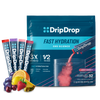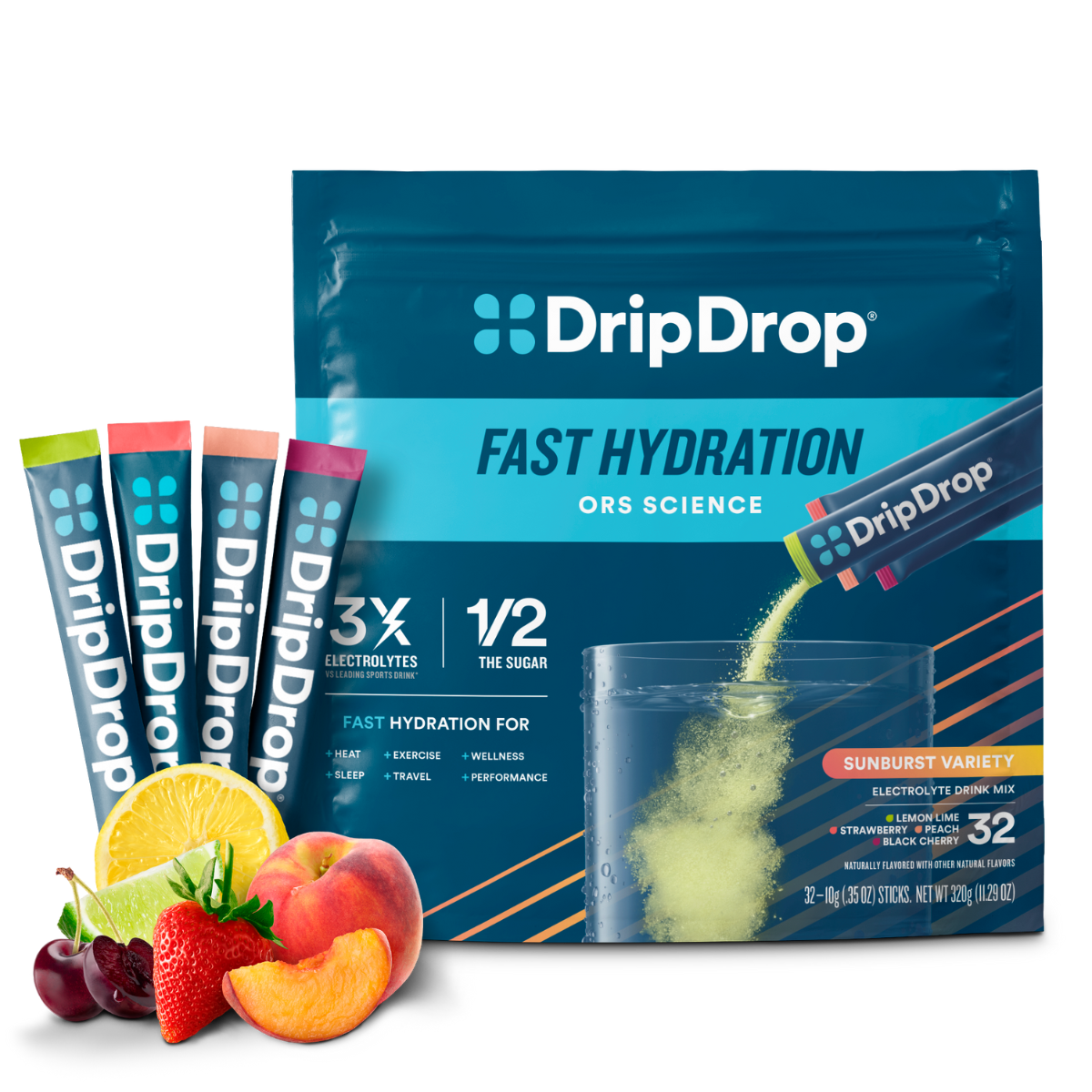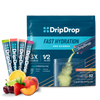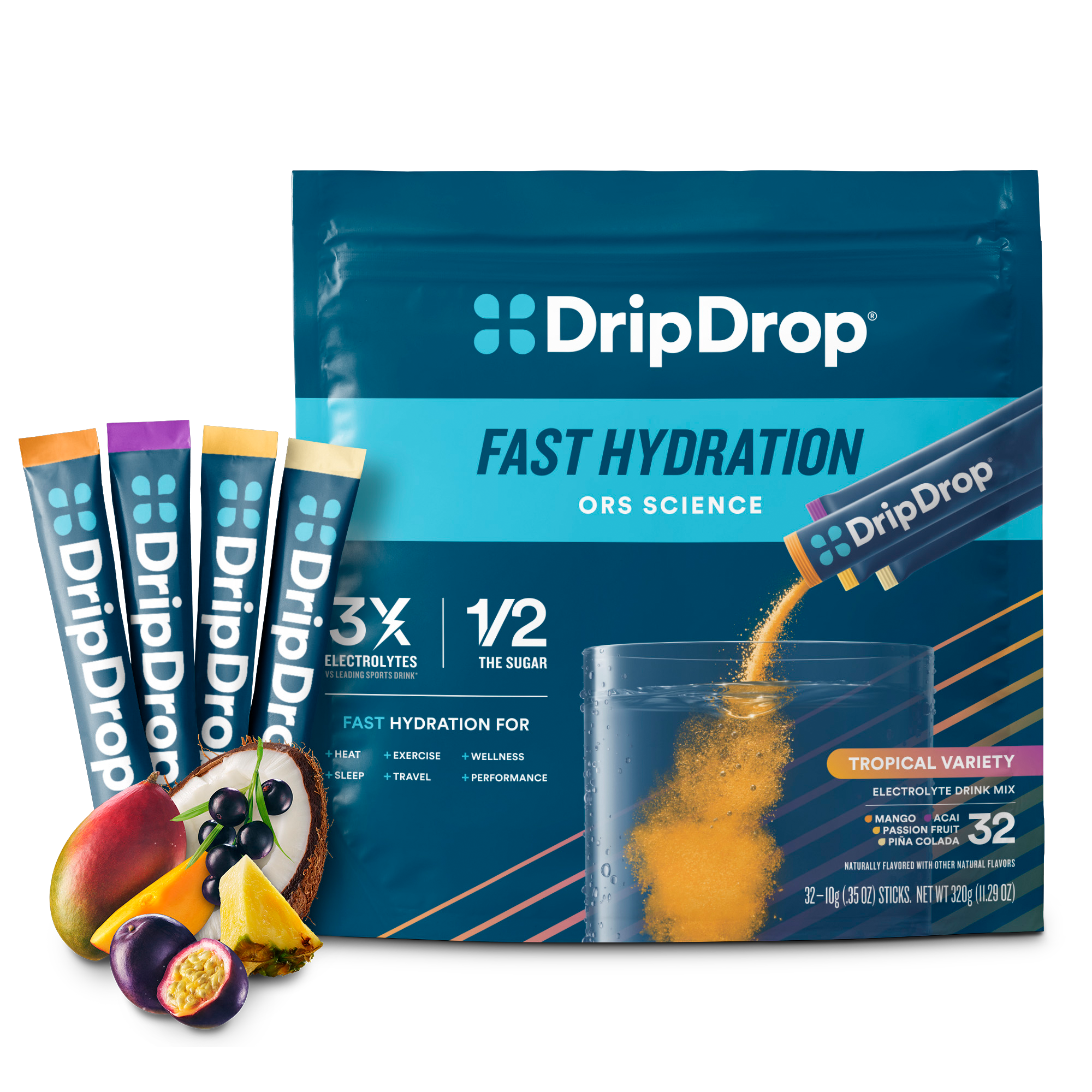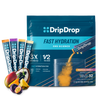A cold sweat is not caused by heat or exertion. You've most likely experienced it before: Maybe you've broken out in a sweat during a fever, your palms might get clammy when you've been anxious, or you've woken up from a nightmare completely drenched in sweat.
Cold sweats are an unpleasant experience, and unlike our body’s normal sweat response, which works to cool down our core temperature, they can be a sign of a medical issue. Cold sweats have been linked to everything from low blood pressure and blood sugar to menopause and anxiety.
Recognizing the difference between regular sweat and cold sweats can alert you when to consult with a medical professional. Find out more about possible causes of cold sweats and dehydration’s impact. Knowing how to rehydrate quickly with an electrolyte drink can boost your body’s ability to fight off the cause of your cold sweats.
Cold Sweats vs. Normal Sweat
Regular sweat is your body's instinctive response to heat. Your body temperature rises for several reasons: high temperatures, wearing many layers of clothing, or exercising. When your internal body temperature rises, you produce sweat, which cools you down as it evaporates.
The main function of sweat is to regulate your core body temperature, known as thermoregulation. When your body cannot cool your core temperature enough, you may experience heat-related illnesses, such as heat exhaustion or heat stroke. If you experience any of these symptoms, seek medical attention right away.
Sometimes, sweat occurs for non-heat-related reasons. When sweat is not brought on by high temperatures or exertion, it is a "cold sweat," known medically as diaphoresis. Regular sweat cools you down and alerts you that your body temperature is rising, so you should seek shade, rest, and water. Cold sweats are alerted similarly, letting you know that something is wrong.
However, many common health conditions can lead to cold sweats. Talk to your doctor to determine the cause. Drink lots of water and boost electrolyte intake to help your body function properly after experiencing cold sweats. Your body loses fluid through sweat, and it’s essential to replenish water and electrolytes to carry out important bodily functions. Electrolyte drinks like DripDrop are designed to hydrate you fast and provide vital electrolytes.
It's important to note that night sweats are another type of sweat people experience. Night sweats can be regular sweating caused by nighttime body temperature fluctuations. Though they're generally not cause for alarm, night sweats can sometimes overlap with cold sweats, so it's important to consider possible causes when they do happen. If you wake up feeling hot with the blankets kicked off, it's most likely your body is sweating due to overheating at night.
What Causes Cold Sweats?
Cold sweats may be a symptom of various health conditions. Treating the underlying cause is often necessary to reduce the frequency of cold sweats, so it is important to be familiar with possible causes. If you experience cold sweats frequently, speak to your doctor to identify potential causes.
Remember that the body loses vital fluid and electrolytes through sweat, whether it’s a thermoregulatory response or cold sweats. Drinking plenty of water and adding electrolytes gives your body the tools to function at its best.
Fever
When you are fighting an infection, your body temperature may rise, causing a fever. Excessive sweating during a fever doesn’t necessarily mean the fever is breaking, as it’s very normal for your body temperature to fluctuate during a fever.
It's also common to alternate between sweating when your temperature drops and shivering when it rises again. This may sound backward, but the air around you feels colder as your body temperature increases, especially if you are already covered in sweat, causing you to shiver. Your body wants to maintain its new temperature, and shivering creates warmth. Staying hydrated when experiencing a fever is absolutely crucial, in part to replace fluids and electrolytes lost to excessive sweating.
Low Blood Sugar
Blood sugar that is too low can cause excessive sweating and must be treated immediately. Low blood sugar, or hypoglycemia, refers to a fasting blood glucose level lower than 70 mg/dL. It can happen to anyone who goes too long without eating, but it is a very common complication among people who have problems managing blood sugar and/or take insulin to manage blood sugar. Hypoglycemia can also occur as the result of developing a resistance to insulin medication.
Shock
Shock often occurs as a result of serious injury or sudden trauma. “Cold sweats occur when pain triggers your body’s fight-or-flight mode,” internal medicine specialist Dr. Andrei Brateanu told the Cleveland Clinic.
If you experience a severe injury, cold sweats could be a sign your body is going into shock and you require immediate medical attention.
Low Blood Pressure
Hypotension, or low blood pressure, is another potential cause of cold sweats. A heart attack or very low heart rate can also cause hypotension. Dangerously low blood pressure can lead to fainting and excessive sweating.
Anyone with low blood pressure should lie down right away and elevate their feet above their heart. Stay hydrated and consume vital electrolytes as dehydration can impact blood pressure. Water is essential to maintaining normal blood pressure as fluid loss leads to lower blood volume which decreases blood pressure.
Anxiety and Stress
Similar to shock, extreme anxiety or fear, such as panic attacks, can also trigger a stress response and cause excessive sweating.
Certain anxiety disorders can make cold sweats more common. For example, hyperhidrosis is a disorder characterized by overactive sweat glands and can be a secondary symptom of other anxiety disorders. Typically, people with hyperhidrosis experience excessive sweating in the hands, feet, and/or underarms.
Cold sweats can also be a side effect of many common antidepressants, as well as antidepressant withdrawal.
Drugs and Alcohol
Certain medications for conditions such as diabetes, cancer, and anxiety or depression can cause cold sweats. Other drugs that list excessive sweating as a potential side effect include prescription pain medications, antibiotics, heartburn meditations, and asthma inhalers.
Sometimes, these drugs are necessary to treat an underlying health condition. In this case, the side effects may be unavoidable and can be treated as separate conditions.
Additionally, excessive sweating is a common symptom of alcohol withdrawal. It is important to seek medical advice any time you stop taking a drug.
Menopause
The hormonal changes that accompany menopause and perimenopause (the transition to menopause) can induce a wide variety of symptoms, including “hot flashes” accompanied by excessive sweating. It is important to understand that menopause is a natural part of female aging and that each symptom of menopause is not necessarily a health issue. However, it is also important to have a plan to manage menopause symptoms, particularly if they become unbearable.
Cold Sweats and Dehydration
While the above health conditions are not an exhaustive list of all possible causes of cold sweats, it is always key to manage the secondary effects of excessive sweating regardless of the cause.
Having the right balance of fluids and electrolytes helps your body perform all its tasks more efficiently, including fighting infections and regulating blood flow and body temperature. DripDrop’s precise formula activates a hydration shortcut that allows your body to absorb fluids and electrolytes more quickly. This electrolyte drink is a fast way to hydrate while consuming electrolytes your body needs.
When to See a Doctor for Cold Sweats
When cold sweats are a symptom of an underlying condition, seek medical care to closely monitor and/or treat the condition. When cold sweats are accompanied by chest pain, palpitations, shortness of breath, and/or extreme nausea or dizziness, this may constitute a life-threatening medical emergency, and you should see a doctor right away.
If you’re not sure what is causing your cold sweats, you may want to seek medical advice to determine if there is an underlying condition. For example, cold sweats or night sweats that have been ongoing for several weeks or longer may necessitate a visit to the doctor.
Use DripDrop to Replace Electrolytes and Fluids
When your body sweats, it loses water and electrolytes. That’s why drinking water may not be enough to get your body functioning at its best.
Instead of choosing a sports drink with too much sugar and sodium, consider a solution such as DripDrop. DripDrop has three times the electrolytes and half the sugar vs the leading sports drink. It also supplies essential vitamins such as zinc, potassium, and magnesium.
Available in a variety of delicious flavors, DripDrop offers a refreshing taste and powerful hydration thanks to its doctor-developed formula. Its convenient package makes it easy to carry and provides access to fast hydration wherever you go.
Try our most popular multi-flavor pouch, or learn more about how you can save up to 25% on every purchase when you subscribe.



